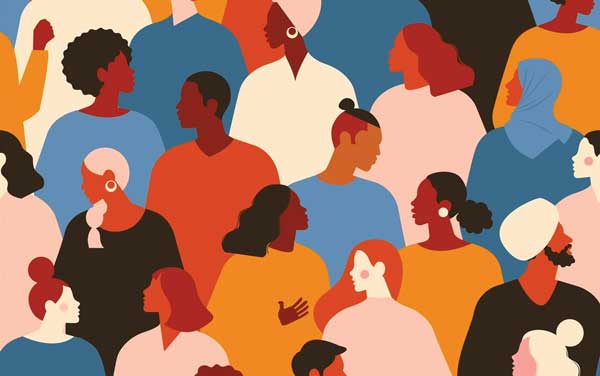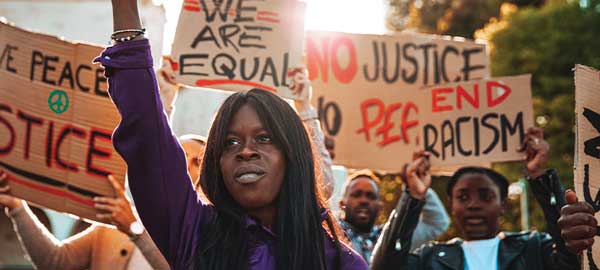Dobbs, Abortion, and Racial Justice
By Hooshyar Afsar
Introduction
Dobbs v. Jackson Women’s Health Organization is the landmark ruling by the Supreme Court of the United States (SCOTUS) in June of this year that, for all intents and purposes, repealed the previous historic SCOTUS decisions of Roe v. Wade (1973) and Planned Parenthood v. Casey (1993), decisions which safeguarded a woman’s choice to terminate an unwanted, untenable, and/or dangerous pregnancy. Various studies show that this SCOTUS ruling has an outsize negative impact on poor Black women in particular and all women of color in general. Yet the economic and social repercussions of the decision reverberate far beyond a woman’s free choice over her body.

Racism and Abortion
The American history of striving for abortion rights is deeply tied to the struggle for racial and gender equality in the United States. There is clear evidence that throughout U.S. history, white supremacists have been adamant in their fight to curb abortion rights due to their fear that women’s freedom of choice over their bodies would result in a decrease in the white population, leading to a loss of white majority in the U.S. population. (1) In contemporary America, the proponents of the “Great Replacement Theory”—those who fear the loss of the white majority status by 2045 (as projected by the U.S. Census Bureau)—see abortion and reproductive rights as a “threat” and, therefore, fully support the Dobbs decision. Similar to many other white nationalist claims, this “logic” of course doesn’t make sense. It is true that, at least prior to Dobbs, white women have had the highest total number of abortions; yet, relative to their share of the U.S. population, Black and Hispanic women have had the significantly higher rates of abortion. This is just another lie that keeps white supremacy’s engine running, which is not a surprise given the history of the racial justice movement in the U.S. is fraught with fighting lies on many fronts. Changes in the makeup of the U.S. population have almost nothing to do with women’s freedom over their bodies and their reproductive health.
One of the primary reasons for Black women and all women of color having higher abortion rates proportional to their share of population is lack of access to preventive care, including access to contraceptives and health counseling. According to an April 2022 article by the U.S. Centers for Disease Control and Prevention (CDC) regarding health equity, “Black women are three times more likely to die from a pregnancy-related cause than White women.” (2) This is yet another consequence of racism in health care and the major disparities that have been out in the open for the American public to see during the pandemic.
Economic Impact of Abortion Restriction on Women of Color and Poor Women
The 1973 Roe v. Wade decision had a significant impact on women’s economic independence and income. There are numerous studies in the past decades that show women’s access to abortion and contraceptives have significantly improved their long-term economic standing and have reduced the gender wage gap. One study shows that access to abortion before the age of 21 and the ability to start a family later in life resulted in a 10% increase in the earnings of Black women. (3) Similar studies show how abortion access contributes to higher levels of education among women and higher earnings. (3) Inversely, there are many indications already that Dobbs will have the opposite impact on women’s economic status both in terms of income and wealth, with the groups most impacted being women of color and especially Black women. For example, the landmark Turnaway study by UCSF-based ANSIRH research program shows that “being denied an abortion leads to a higher chance of being in poverty up to 4 years later and a lower likelihood of having positive personal life goals in the coming year.” (4)
Post-pandemic consequences have made the situation even worse. While mothers’ roles were critical in keeping the social fabric of society together, they bore the economic brunt of the pandemic. According to Forbes, over 650,000 women who lost their jobs as a result of the pandemic have not yet gained re-employment. (5) Add to this the fact that 60% of women who have abortions in the United States already have children and close to 70% of all women having abortions are women of color, with Black women having the most disproportionate share. The picture is clear: while all women’s economic livelihoods are negatively impacted by Dobbs, women of color and primarily Black women will be hurt the most.
There is already talk that there will be a women’s wage reduction even in the 25 (or 24) states that will not ban abortion via a negative surcharge for having access to reproductive health. This means that women will be paid less even in the states that keep abortion legal just because they have access to it. Leaving this to the discretion of large companies, some of whom have put policies in place to protect their women workers’ access to reproductive health and abortion, will be short lived if it is not followed by federal and state legislations to protect women’s pay. Considering the historic failure of passing the Equal Rights Amendment to the U.S. Constitution and patriarchy riding the capitalist profit machine, it will be a catastrophic mistake to leave this up to the corporations’ senior executives. Unfortunately, until protective legislation is put in place, Dobbs will make the gender pay gap worse everywhere.

Social and Health Impacts
There is no doubt that negative economic impact will be followed by social consequences. There are already numerous reports of women’s health being jeopardized by lack of access to abortion even in cases where there is clear evidence that continuation of pregnancy has already endangered the health of the mother. Many anti-abortion activists have been forced to react by denying the extent of the problem and rejecting the reports as exaggerations by pro choice activists as spelled out in a recent New York Times op-ed piece. (6)
The continuation of more unwanted pregnancies will force many women, primarily women of color, below or to the fringes of the poverty line and will lower their socio-economic status. The landmark Turnaway study again shows the short- and long-term impacts of denying abortion on the mental and physical health and socio-economic status of women and their families. This will in turn impact the future living standards of the children who grow up in these households. For example, “[t]he children women already have at the time they seek abortions show worse child development when their mother is denied an abortion compared to the children of women who receive one.” (7) According to LISC (Local Initiative Support Corporation), “women denied an abortion are three times more likely to be unemployed than women who were able to end an unwanted pregnancy. They are more likely to experience economic hardship and insecurity that could last a lifetime.” (8)
Dobbs and the Iranian American Community
Many of us in the Iranian American community may think that Dobbs will not have much of an impact because women of Iranian descent in the U.S. have higher standards of living, including education and access to medical care. I beg to disagree. Women in our community will be impacted either in terms of worsening gender pay gap or risk of continuation of their unwanted, untenable, and/or dangerous pregnancies in at least 25 states that have either banned or will ban abortion at any stage of pregnancy. Dobbs once again makes the case for activism and solidarity with all communities of color (specifically immigrant communities of color) even stronger. If you think you or your loved ones are not affected, think again.
Will Dobbs Backfire?
There are already polls that show more enthusiasm on the pro-choice side to participate in the upcoming U.S. midterm elections in November. (9) According to FiveThirtyEight, a political polling organization, various polls have shown a generic ballot poll 3 point shift in favor of Democrats post-Dobbs compared to the same polls conducted pre-Dobbs. (10) The situation has gotten better for Democrats more recently where their chance of winning the Senate (bigger majority of current 50-50) has also improved. So far, the political repercussions of Dobbs have not subsided and this is not good news for supporters of an abortion ban. In fact, as recently as August, Kansas voters rejected a constitutional amendment that would have removed the right to abortion from the State Constitution by an 18% margin. Yes, that happened in Kansas! If Democrats are able to control Congress after the midterms in November and gain a larger majority in the Senate (granted that it is still a big if), they could pass federal legislation to protect abortion rights. Again, the long-term strength is in the movements. Between now and November, progressive organizers could make a difference and help turn the tide toward a brighter future.
1- https://fivethirtyeight.com/features/how-the-fight-to-ban-abortion-is-rooted- in-the-great-replacement-theory/
2- https://www.cdc.gov/healthequity/features/maternal-mortality/index.html
3- https://equitablegrowth.org/factsheet-what-the-research-says-about-the- economic-impacts-of-reproductive-care/
4- https://www.ansirh.org/research/ongoing/turnaway-study
5- https://www.forbes.com/sites/hollycorbett/2022/06/07/how-overturning-roe- v-wade-can-impact-the-economy/?sh=3487315b632f
6- https://www.nytimes.com/2022/07/29/opinion/anti-abortion-movement.html
7- https://www.ansirh.org/sites/default/files/publications/files/the_harms_of_denying_a_woman_a_wanted_
abortion_4-16-2020.pdf
8- https://www.lisc.org/our-stories/story/what-supreme-courts-dobbs-ruling- means-our-communities-and-our-work/
9- https://www.lx.com/politics/democrats-young-voters-have-closed-the- enthusiasm-gap-4-months-before-2022-midterms/55009/
10- https://fivethirtyeight.com/features/maybe-dobbs-did-change-the-race-well- need-more-time-to-know-for-sure/
Hooshyar Afsar is one of the founders of Racism Awareness Project (RAP), an educational program on the history of and present-day racism in the United States and its impact on the Iranian American community. RAP has had a variety of educational forums across the United States. Mr. Afsar has written several articles and book reviews on the topic for Peyk and other publications. He can be reached at hoosh.afsar@rapusa.org.


















